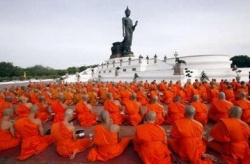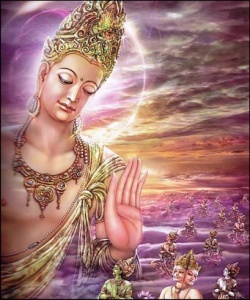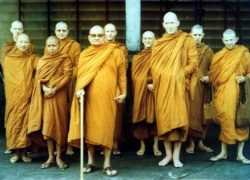All Dhammas
These succinct phrases describing the three characteristics of reality are a well-known summary of the Buddha’s teaching. They are profound, radical, even devastating in their philosophical implications. But, true to the pragmatic orientation of the Dhamma, their chief purpose is not to fuel coffee-table debates on the meaning of life, but to orient our inner explorations, providing concise yet comprehensive guidelines for insight meditation.
As such, the meaning of these phrases would seem to be of no little interest for those pursuing the Buddha’s way of calm and insight. Yet their precise interpretation remains elusive, particularly the enigmatic shift from ‘saṅkhāras’ to ‘dhammas’ in the third phrase. Both of these terms are highly ambiguous, assuming a variety of meanings in different contexts. Here I will leave them untranslated so as to not colour the interpretation.
One popular contemporary interpretation sees saṅkhāras here as ‘conditioned phenomena’, or more precisely, the phenomena of experience as active participants in an ongoing process of cause and effect. Dhammas is seen as being broader, including conditioned phenomena plus Nibbana, the unconditioned. Doubt has been thrown on this view, however, because Nibbana is never directly referred to as ‘not-self’ in the suttas. The purpose of this contemplation is to become repulsed from suffering, so one contemplates phenomena as ‘not-self’, ‘a disease’, ‘a barb’, ‘an affliction’, etc. Obviously, Nibbana does not come within the scope of such contemplation.
It has been pointed out, however, that Nibbana is referred to as ‘not-self’ in the Vinaya Parivāra. This late compendium of monastic discipline is an odd place indeed to find such a statement, but at least this shows that such ideas were considered orthodox by the emerging Theravada school.
One reason for the popularity of the view that ‘all dhammas’ includes Nibbana has been to counter the opinion of some prominent scholars that Nibbana is a kind of higher ‘Self’. The persistence of such ideas is quite astonishing in light of the Buddha’s consistent and unsparing condemnation of all doctrines of self, and the total lack of any hint that Nibbana is a ‘self’. However, it does not necessarily follow that the statement ‘all dhammas are not-self’ refers to Nibbana. In fact, it’s a weak argument. One should never rely on a disputed interpretation of an ambiguous term to buttress one’s position in a debate.
The Theravada commentaries offer conflicting opinions on this point – a sure sign that the teachers of old were not unanimous. One explanation has it that saṅkhāras here means the ‘aggregate of saṅkhāras’ (i.e. various mental factors headed by volition), while dhammas means all five aggregates. I find this interpretation too arbitary to do justice to the context. Elsewhere the commentaries suggest that dhamma includes ‘concepts’ along with conditioned phenomena. This is interesting, but it rests on philosophical premises more characteristic of later strata of Buddhist thought, namely the distinction between ultimate truth and conventional truth.
The main problem with all the above theories is that they lack sutta support. Ideally we should like an important sutta dealing directly with the three characteristics which refers to something as a dhamma while stating or implying that that dhamma is neither impermanent nor suffering. To find such a passage we need look no further than the well-known ‘Discourse on the Lawfulness of Dhamma’. I translate only the relevant portions.
‘All saṅkhāras are impermanent.’ Whether Tathagatas arise or not, that element is stable, that stability of dhamma, that lawfulness of dhamma…
‘All saṅkhāras are suffering.’ Whether Tathagatas arise or not, that element is stable, that stability of dhamma, that lawfulness of dhamma…
‘All dhammas are not-self.’ Whether Tathagatas arise or not, that element is stable, that stability of dhamma, that lawfulness of dhamma…
“
The idea is that the principles of the Dhamma are always true. Things are impermanent. In the past they were impermanent. In the future, too, they will be impermanent. While the sutta stops short of such a bold statement as ‘impermanence is permanent’, still the terms ‘stability’ and ‘lawfulness’ are virtually the opposite of ‘impermanence’.
If the principles of the dhamma cannot be regarded as impermanent, neither, it would seem, should they be regarded as suffering. They are not mentioned in the usual descriptions of suffering, nor do they fall into the threefold analysis of suffering as the suffering of painful feeling, the suffering of saṅkhāras, and the suffering of change.
So the principles of impermanence, suffering, and selflessness are the ‘dhamma’ which is not impermanent or suffering; yet it seems plain enough that such principles are not-self. This is confirmed in a related discourse, which uses similar phrases such as the ‘stability of dhamma’ in the context of dependent origination. While the factors of dependent origination, the ‘dependently originated phenomena’ headed by ignorance, are impermanent, the causal relationship between the phenomena remains fixed. Whenever there is ignorance, that will always give rise to conceptual activities, and so on. And it is precisely this consistent manner in which experience operates which creates the illusion of ‘self’, of a permanent essence or core underlying the transient fluctuations of experience. To see through this illusion, the Buddha taught us to make the conditional relation itself a focus of our investigation, to see experience neither as a random meaningless chaos, nor as diverse surface manifestations of a hidden inner unity, but as a flow of transient phenomena governed by natural laws.
The three characteristics themselves are really little more than another perspective for examining conditionality. The suttas often treat ‘impermanent’ as a virtual synonym for ‘dependently originated’. So in the end we can summarize like this. Saṅkhāras means ‘conditioned phenomena’, while ‘dhammas’ encompasses the conditioned phenomena as well as the principles of conditionality.
This is useful. It reminds us that insight is not just ‘bare awareness’ of transient phenomena, but must lead to an act of understanding, an intuitive realization of their fundamental nature. Seeing that ‘this thought is impermanent’, ‘this feeling is suffering’, ‘this idea is not-self’, we can let go of that thought, that feeling, that idea. But only when we see that ‘all thoughts are impermanent’, ‘all feelings are suffering’, ‘all ideas are not-self’ can we let go of all thoughts, all feelings, all ideas.
The key to thus universalizing the particulars of one’s own experience is conditionality. Again and again and again one sees thoughts arising when certain conditions are present; and again and again and again one sees that when those conditions are absent, thoughts do not arise.
One bright day it clicks: one understands. This inner event is really quite mysterious. No-one can say how or when it will occur; and yet we can point out how to bring it about. When it happens, one has no thought of identifying or clinging to the passing parade of phenomena, the Mardi-gras of the mind, for one understands: all dhammas are not-self.



